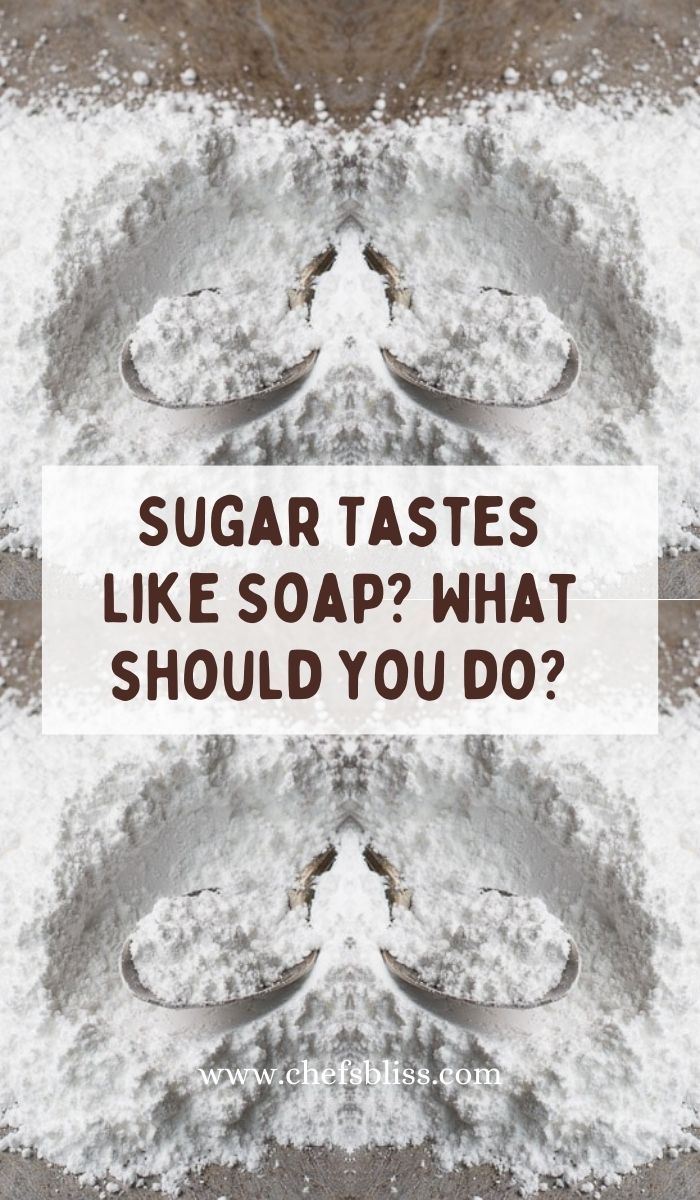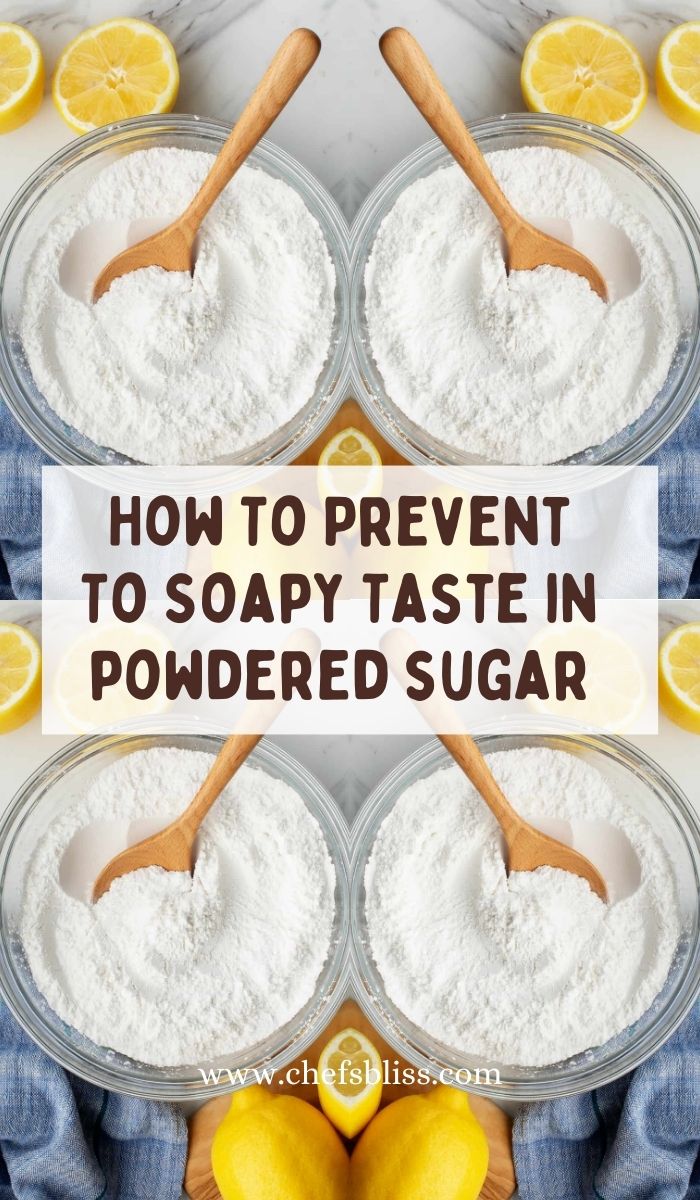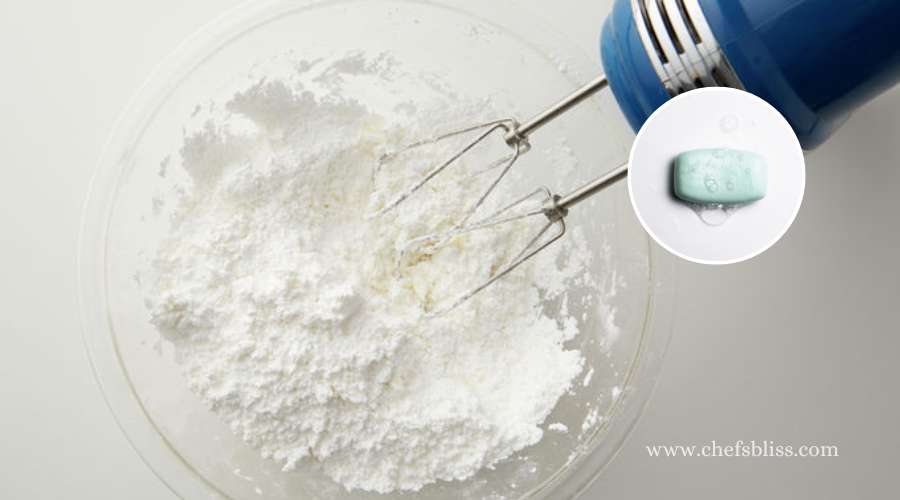Every product is independently reviewed and selected by our editors. If you buy something through our links, we may earn an affiliate commission at no extra cost to you.
Powdered sugar, with its fine texture and sweet allure, is a kitchen staple cherished by bakers and cooks alike.
But what happens when that innocent-looking white powder takes an unexpected twist and tastes like soap?
It’s a perplexing occurrence that can leave you questioning the integrity of your ingredients.
In this article, I’ll dive into the curious world of powdered sugar that tastes like soap, exploring the potential causes, debunking myths, and offering practical solutions.
Why Does My Powdered Sugar Taste Like Soap? What Makes It Taste Like Soap?

The taste of powdered sugar resembling soap can be perplexing and frustrating.
However, this unexpected flavor is likely the result of a few different factors that might interact in unusual ways.
Here are some reasons for the soapy taste in powdered sugar:
Cross-Contamination
If the utensils or containers used to store powdered sugar were previously used for soap or cleaning products, traces of these substances might linger and affect the taste.
Chemical Residue
Sometimes, powdered sugar packaging might contain traces of chemicals or cleaning agents, which could transfer onto the sugar, leading to a soapy taste.
Environmental Contaminants
Dust, debris, or pollutants in the environment where the powdered sugar is stored could potentially find their way into the sugar, altering its taste.
Personal Sensitivity
Individual taste perceptions can vary widely. Some people might be more sensitive to certain compounds that cause the soapy taste, even at very low levels.
Chemical Reactions
Some ingredients in the powdered sugar or in recipes where it’s used might react in unexpected ways, resulting in the perception of a soapy taste.
Storage Conditions
If the powdered sugar is exposed to moisture or humidity, it could potentially lead to chemical reactions or bacterial growth that affects its flavor.
Powdered Sugar Tastes Like Soap – What Should I Do Now

Encountering powdered sugar that tastes like soap can be concerning, but there are several steps you can take to address the issue:
Check for Contamination:
Inspect the utensils, containers, and storage areas where you keep powdered sugar.
Make sure they are clean and free from any residue of cleaning agents or other contaminants.
Change Containers:
If you’ve been using a container that previously held cleaning products, it might be a good idea to switch to a new, clean container specifically designated for food storage.
Try a Different Brand:
If the issue persists across different batches, consider trying powdered sugar from a different brand to see if the taste problem persists.
Contact the Manufacturer:
Reach out to the manufacturer of the powdered sugar to inquire about the taste issue.
They might be able to provide insights into any potential changes in production or packaging.
Store in a Dry Place:
Ensure that your powdered sugar is stored in a cool, dry place to prevent any potential interactions with moisture or humidity.
Experiment with Other Sweeteners:
If the issue persists and you’re unable to resolve it, you could explore alternative sweeteners like granulated sugar or natural sweeteners that don’t exhibit the same taste issue.
Rule Out Allergies or Sensitivities:
In rare cases, individual allergies or sensitivities might cause certain flavors to be perceived differently. Consult a healthcare professional if you suspect this might be the case.
Practice Good Hygiene:
Be mindful of the utensils and hands that come into contact with the powdered sugar during cooking and baking.
Make sure they are clean and free from any residues that could alter the flavor.
Test in Small Amounts:
If you’re determined to continue using the powdered sugar, try using it in a small amount in recipes where the taste might be less noticeable.
How To Prevent To Being Powdered Sugar Tastes Like Soap

Preventing powdered sugar from tasting like soap involves a combination of proper handling, storage, and awareness.
While the occurrence is uncommon, here are some steps you can take to minimize the chances of encountering this issue:
Dedicated Utensils:
Use utensils that are exclusively designated for food handling and storage. Avoid using utensils that have previously come into contact with cleaning products.
Clean Storage Containers:
Ensure that the containers you use to store powdered sugar are thoroughly cleaned and free from any residue or contaminants.
Proper Storage:
Store powdered sugar in a cool, dry place, away from direct sunlight and sources of moisture. Humidity can lead to unwanted chemical reactions or contamination.
Avoid Cross-Contamination:
Keep powdered sugar away from cleaning supplies or chemicals. Store it separately from household items that could potentially transfer unwanted flavors.
Choose Reliable Brands:
Opt for reputable and well-known brands of powdered sugar to reduce the likelihood of encountering taste issues.
Check Packaging:
Inspect the packaging of the powdered sugar for any unusual odors or visible signs of contamination before purchase.
Good Hygiene Practices:
Wash your hands thoroughly before handling powdered sugar, and ensure that all utensils and surfaces are clean.
Sift Before Use:
If you’re concerned about the quality of powdered sugar, consider sifting it before using it in recipes. This can help you identify any foreign substances or clumps.
Use Fresh Batches:
Rotate your powdered sugar stock, using older batches first to minimize the chances of storage-related issues.
Monitor for Changes:
If you notice a change in taste, odor, or texture of powdered sugar, discontinue use and investigate the cause.
By following these steps and being vigilant about proper handling and storage practices, you can significantly reduce the chances of encountering powdered sugar that tastes like soap.
Is It Safe To Consume Powdered Sugar That Has A Soapy Taste
While consuming powdered sugar that has a soapy taste might not be immediately harmful in terms of causing acute illness, I will advise you not to consume any food that tastes unusual or off-putting.
The presence of a soapy taste in powdered sugar is a clear sign that something is not right, and there could be underlying issues, such as contamination or chemical interactions, that are causing the taste.
In addition to the unpleasant taste, there is a risk that the powdered sugar might have been contaminated with substances that are not meant for consumption.
Even if there are no immediate adverse effects, consuming such food could lead to long-term health risks or discomfort.
To ensure your safety and enjoyment of food, it’s best to avoid consuming powdered sugar that has a soapy taste.
Instead, focus on preventing the issue by practicing good hygiene, proper storage, and using powdered sugar from reputable sources.
If you consistently encounter this taste issue, consider reaching out to the manufacturer for guidance or exploring alternative sweeteners that don’t have the same taste problem.
Is It Normal For Powdered Sugar To Have A Soapy Taste?
No, it is not normal for powdered sugar to have a soapy taste. Powdered sugar, also known as confectioners’ sugar or icing sugar, should have a sweet and neutral taste, without any unusual or off-putting flavors.
If you encounter powdered sugar with a soapy taste, it’s important to recognize that this is not a typical characteristic of high-quality powdered sugar.
The presence of a soapy taste usually indicates a problem with the product, such as contamination, chemical interactions, or other issues that might have affected its flavor.
Can Certain Brands Of Powdered Sugar Taste Like Soap?
It is highly unusual for any reputable brand of powdered sugar to taste like soap. The taste of soap is not a normal characteristic of powdered sugar, regardless of the brand.
Powdered sugar should have a sweet and neutral flavor, and any deviations from this taste could be indicative of contamination, improper storage, or other issues.
If you find that a specific brand of powdered sugar consistently has a soapy taste, it’s important to investigate the source of the issue.
Consider checking the storage conditions, the utensils and containers used, and whether there could be any cross-contamination with cleaning products or other substances.
Can Improper Storage Of Powdered Sugar Lead To A Soapy Taste?
Improper storage of powdered sugar can potentially lead to a change in its flavor, including the development of a soapy taste.
Powdered sugar is sensitive to moisture, temperature fluctuations, and exposure to other odors, which can affect its quality over time.
Here’s how improper storage might contribute to a soapy taste:
Moisture Absorption:
If powdered sugar is stored in a humid or damp environment, it can absorb moisture.
This moisture can lead to clumping and the growth of microorganisms, which might result in an off-flavor, including a soapy taste.
Cross-Contamination:
If powdered sugar is stored near cleaning products or other strong-smelling substances, it can absorb these odors, altering its taste.
Chemical Reactions:
Exposure to certain chemicals or fumes from cleaning products or other substances might lead to chemical reactions that affect the taste of the powdered sugar.
Temperature Changes:
Frequent temperature changes, especially if the powdered sugar is stored in an area prone to fluctuations, can impact its texture and potentially contribute to a change in taste.
Can The Soapy Taste Be Masked When Using Powdered Sugar In Recipes?
Attempting to mask a soapy taste in recipes by using powdered sugar is not recommended.
The taste of soap in powdered sugar indicates a potential issue with the quality and safety of the product, and using it in recipes might not necessarily eliminate the off-putting flavor.
Incorporating powdered sugar with a soapy taste into recipes could affect the overall taste and quality of the dish, potentially rendering it unpalatable.
Additionally, masking a taste issue does not address the underlying problem, which could be related to contamination, improper storage, or other factors.
Does The Soapy Taste In Powdered Sugar Indicate Spoilage?
The soapy taste in powdered sugar is not necessarily an indication of spoilage in the same way that it might be for other types of food.
Instead, the soapy taste suggests that the powdered sugar might have been contaminated or exposed to substances that are affecting its flavor.
Powdered sugar itself doesn’t typically spoil in the same sense that perishable foods do.
However, it can degrade in quality over time due to factors like moisture, exposure to odors, and chemical interactions.
The presence of a soapy taste suggests that the powdered sugar has undergone changes that have altered its original taste profile.
While the powdered sugar might not be spoiled in the traditional sense, it’s advisable to avoid consuming or using it in recipes if it has an unusual taste.
The soapy taste could indicate that the powdered sugar has been compromised in some way, and using it could affect the taste and quality of your dishes.
Can The Type Of Sweetener Used In Powdered Sugar Affect Its Taste?
Yes, the type of sweetener used in powdered sugar can affect its taste.
Traditional powdered sugar, also known as confectioners’ sugar or icing sugar, is made by grinding granulated sugar into a fine powder and then adding a small amount of cornstarch to prevent clumping.
The primary ingredient in powdered sugar is sugar itself.
If an alternative sweetener or sugar substitute is used in place of granulated sugar during the production of powdered sugar, it could potentially lead to a different taste profile.
Different sweeteners have varying levels of sweetness and might have distinct flavor characteristics that could impact the overall taste of the powdered sugar.
However, a soapy taste in powdered sugar is unlikely to be solely attributed to the type of sweetener used.
The presence of a soapy taste is more likely linked to contamination, improper storage, or other factors unrelated to the sweetener itself.
Does Sifting Powdered Sugar Help Eliminate The Soapy Flavor?
Sifting powdered sugar might help eliminate small clumps or lumps in the sugar, but it is unlikely to completely eliminate a soapy flavor if the taste issue is due to contamination or other factors.
Sifting is primarily a technique used to ensure a smooth texture in powdered sugar and to prevent any clumps from forming in recipes.
If the powdered sugar has developed a soapy flavor, it’s more likely that the issue is related to contamination, improper storage, or other factors that have altered the taste of the sugar itself.
Simply sifting the sugar is not likely to address these underlying causes.
To address a soapy flavor in powdered sugar, it’s better to focus on proper storage, handling, and purchasing practices.
If you consistently encounter powdered sugar with an undesirable taste, consider contacting the manufacturer for guidance or exploring alternative sources to obtain a fresh batch of high-quality powdered sugar.
Conclusion
While it’s perplexing to encounter powdered sugar with a soapy taste, it’s far from the norm. Powdered sugar should be a delightful addition to your culinary creations, enhancing flavors, not detracting from them. Cross-contamination, chemical interactions, or improper storage could contribute to this unusual flavor.
By prioritizing proper storage, using clean utensils, and selecting reliable brands, you can reduce the chances of encountering a soapy taste in your powdered sugar.

